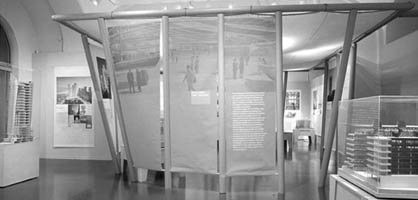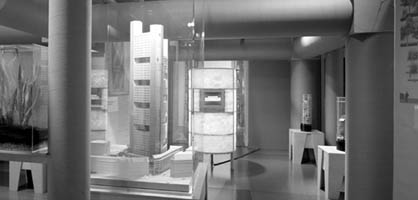|
sito + "/AREA=" + sezione + "/AAMSZ=" + misura + "/ACC_RANDOM=" + bumber + "/PAGEID=" + pageid + "'>"); document.write(""); |
| home > allestimenti |
|
sito + "/AREA=" + sezione + "/AAMSZ=" + misura + "/ACC_RANDOM=" + bumber + "/PAGEID=" + pageid + "'>"); document.write(""); |
| home > allestimenti |
| Untangling
the nature of sustainable architecture David Gissen |
||||
| The
National Building Museum in Washington DC hosted, between January 17th
and June 22nd 2003, a significant exhibit on large-scale architectural
projects addressing environmentally sustainable methods and practices.
All issues that, given the explosive expansion of world cities in the
past centuries, often at odds with environmental concerns, are today
especially challenging. "Big & Green: Toward Sustainable Architecture
in the 21st Century" is introduced, on the pages of ARCH'IT, through
two presentations by David Gissen, curator of the exhibit, who describes
how, with a genuine sense of curiosity as well as a sense of irony,
he untangle the "nature" of sustainable architecture while
attempting to explain how environmentalism and big-business interacted;
and James Hicks (Big & Green),
the architect in charge of the exhibit design, who designed an exhibition
about sustainable building principles while upholding said principles.
[PG] |
||||
| When I was asked in 2000 by the National Building Museum to explore the possibility of developing an exhibition and publication on sustainable architecture, I reacted with more than hesitation. "Sustainable development," "the environment," and "natural resource management" -to name three of the operative terms of contemporary sustainable architecture- seemed less descriptors of an architectural approach and more descriptors of a mythic cult that mixed nature, science and nationalist geographic tendencies in an uneasy alliance. Rather than explore how these ideas came together in the home (as was originally suggested to the curatorial team and as I believe would further collapse nature and ideology together) our curatorial team decided to untangle the "nature" of sustainable architecture by exploring the efforts to make environmentalist skyscrapers and other large-scale buildings. |
[28aug2004] | |||
 The exhibition began to take shape in the summer of 2001; it contained a strong sense of irony regarding the projects reviewed, but a genuine sense of curiosity as to how environmentalism and big-business interacted. We explored the way air in tall buildings was re-organized by architecture and engineering firms to lessen the use of air conditioning. We examined efforts by engineers to re-think the use of water and the incorporation of greenery in tall buildings. Energy generation was also examined as well; we reviewed numerous tall building designs that incorporated wind turbines and solar cells. While remaining suspicious of the "green" rhetoric, I was staring to be convinced that this work was actually very interesting. |
||||
 The events of September 11th, 2001 forced us to re-think our exhibition, and to determine what was important about this show at a time when people were increasingly afraid of both terrorism and tall buildings. We politely resisted pressure to re-symbolise the skyscraper as a tool of resistance against global terrorism; to chart the emergence of the skyscraper in the forms of nature, or the other suggestions for this increasingly volatile exhibition. Mounting an exhibition on tall buildings was enough of a statement at the time, and visitors to the museum were certainly capable of debating the merits of these buildings without us attempting to "re-symbolize" the skyscraper, or the capitalism it represents, as a work of nature itself. |
||||
 The exhibition design team of Paul Carlos and Urshula Barbour of Pure+Applied and exhibition architect James Hicks of James Hicks Design were a perfect pairing for this increasingly complex and political exhibition project. Pure+Applied's academic, cerebral approach to design was much appreciated and needed. James Hicks is an architect who cut his teeth in several progressive architecture firms and his work for the Natural History Museum in New York informed the direction of the exhibition planning. James Hicks knew how to make both bricks and ferns exciting for the visitor, while Paul Carlos and Urshula Barbour took an unbelievable amount of empirical data, lending it legibility and organization. The combination of our efforts resulted in what became a highly influential and popular show on a topic that deserves continued debate. David Gissen |
||||
| >
ALLESTIMENTI: JAMES HICKS: BIG & GREEN > NATIONAL BUILDING MUSEUM |
||||
| ARCH'IT
books consiglia: David Gissen (Editor) Big & Green: Toward Sustainable Architecture in the 21st Century Princeton Architectural Press, 2002 pp192, acquista il libro online! |
||||||
| La
sezione Allestimenti laboratorio
|